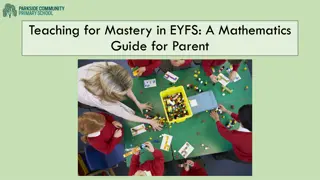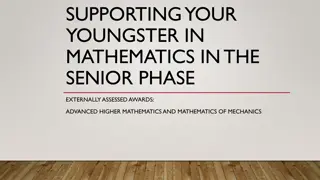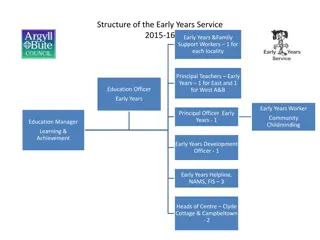Early Years Foundation Stage Mathematics Information for Parents 2023
In the Early Years Foundation Stage (EYFS), children are taught Mathematics following the DFE Statutory Framework and Development Matters Guidance. The focus areas include Number and Numerical Patterns. By the end of the Reception year, children are expected to achieve various skills such as understanding numbers to 10, subitizing up to 5, recalling number bonds, verbally counting beyond 20, and exploring patterns within numbers. The key skills covered include reciting numbers in sequence, one-to-one correspondence, and recognizing number words and numerals in everyday situations. Extended counting forwards and backwards helps prepare children for addition and subtraction.
Download Presentation

Please find below an Image/Link to download the presentation.
The content on the website is provided AS IS for your information and personal use only. It may not be sold, licensed, or shared on other websites without obtaining consent from the author. Download presentation by click this link. If you encounter any issues during the download, it is possible that the publisher has removed the file from their server.
E N D
Presentation Transcript
EYFS Mathematics information for parents 2023
In the Early Years Foundation Stage we teach using the DFE Statutory Framework for the Early Years Foundation Stage and the Development Matters Guidance. The teaching of Mathematics in the Early Years Foundation Stage (EYFS) is split into 2 areas: Number Numerical Patterns
Number By the end of the Reception year it is expected that most children will be able to achieve most of the following: Have a deep understanding of number to 10, including the composition of each number Subitise (recognise quantities without counting) up to 5 Automatically recall (without reference to rhymes, counting or other aids) number bonds up to 5 (including subtraction facts) and some number bonds to 10, including double facts.
Numerical Patterns By the end of the Reception year it is expected that most children will be able to achieve most of the following: Verbally count beyond 20, recognising the pattern of the counting system. Compare quantities up to 10 in different contexts, recognising when one quantity is greater than, less than or the same as the other quantity. Explore and represent patterns within numbers up to 10, including evens and odds, double facts and how quantities can be distributed equally.
Numbers Basic Key Skills: Reciting numbers in sequence. Can use one-to-one correspondence Realises that anything can be counted (steps, claps, jumps). Understands that the number of objects stays the same even if they are moved around or grouped in different ways. The importance of zero.
Number Words and Numerals Look out for numerals and number words in everyday situations.
Extended Counting Forwards 3, 4, 5, 6, 7... 6, 7, 8, 9, 10... 8, 9, 10, 11, 12 Backwards 11, 10, 9, 8, 7 6, 5, 4, 3, 2 This skill prepares children for addition and subtraction.
Counting objects that cannot be moved or touched Counting actions or sounds Move around, or partition and recombine small groups of objects, and recognise that the total is still the same (pre- step to learning number bonds). Counting up to 10 objects in any arrangement, not just when they are in a straight line
Addition skills Use practical materials. Find the total number of items in 2 groups by counting all of them. Varied language adding total how many altogether makes equals Recognise that addition can be done in any order. E.g. 5 + 3 = 8 AND 3 + 5 also = 8, 8=5+3.
Stages in Teaching Addition Step 1
Step 6 Put the first number in your head 5 + 3 = says 5 . 6, 7, 8 Not 1, 2, 3, 4, 5 6, 7, 8 This takes time and needs a secure knowledge of the number system and what number comes next. This needs lots of practise.
Subtraction Remember counting backwards practise Count a set of objects then remove some. Ask, How many are left? Varied vocabulary take away, minus, subtract, how many are left?
Subtraction How many apples are there? Take away 2 apples. How many do you have left? To extend this add numerals and calculation symbols (- and =).
Subtraction Eventually take the objects/pictures away and display the number sentence. Allow your child to use objects, drawings and fingers to work this out. 4 2 =
Applying their Knowledge Through Problem Solving Explore and solve problems in practical contexts Use meaningful examples that will be motivate your child to use their mathematical skills. Encourage critical thinking and a have a go attitude. Asking questions such as What could we do next? and How shall we do it?
Keep maths practical and have fun! Bath-time (filling and emptying containers, counting, timing how long it takes to fill the bath) Counting rhymes Talk about numbers in the environment (front door numbers, number plates, road signs etc) Help with the cooking (measuring, weighing, ordering the recipe) Setting table places (how many plates/cups etc) Paying in shops (including change) Estimating amounts (how many apples/sweets?) Shopping helping to count out varying amounts of fruit and vegetables























